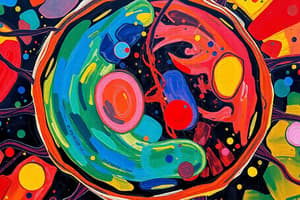Podcast
Questions and Answers
What role do enzymes play in chemical reactions within cells?
What role do enzymes play in chemical reactions within cells?
- They bond with products to deactivate them.
- They increase the activation energy required for reactions.
- They act as substrates in the reactions.
- They lower the activation energy needed for the reactions. (correct)
What is required for an enzyme to effectively facilitate a reaction?
What is required for an enzyme to effectively facilitate a reaction?
- Prolonged interactions with substrates (correct)
- Formation of allosteric inhibitors
- High temperatures and pressures
- Excessive substrate concentration
Which of the following statements about enzymes is true?
Which of the following statements about enzymes is true?
- Enzymes can only catalyze one type of reaction.
- Enzymes are permanently altered after a reaction.
- Enzymes are highly selective and produce only required compounds. (correct)
- Enzymes eliminate the need for substrates.
What characterizes activated carriers in biological systems?
What characterizes activated carriers in biological systems?
Which activated carrier is considered the most important for energy transfer?
Which activated carrier is considered the most important for energy transfer?
What does Delta G (ΔG) signify in a chemical reaction?
What does Delta G (ΔG) signify in a chemical reaction?
Which statement best describes the 2nd law of thermodynamics as it relates to chemical reactions?
Which statement best describes the 2nd law of thermodynamics as it relates to chemical reactions?
What is the role of activation energy in spontaneous reactions?
What is the role of activation energy in spontaneous reactions?
Which of the following pathways is correctly associated with biosynthesis?
Which of the following pathways is correctly associated with biosynthesis?
What are neurotransmission and potential gradients primarily influenced by?
What are neurotransmission and potential gradients primarily influenced by?
What is the primary role of enzymes in cellular processes?
What is the primary role of enzymes in cellular processes?
Which of the following best describes activated carriers?
Which of the following best describes activated carriers?
What occurs during ATP hydrolysis?
What occurs during ATP hydrolysis?
How do cells primarily obtain the energy needed for metabolic processes?
How do cells primarily obtain the energy needed for metabolic processes?
What does reaction coupling in metabolic processes involve?
What does reaction coupling in metabolic processes involve?
According to the 1st Law of thermodynamics, what can be stated about energy?
According to the 1st Law of thermodynamics, what can be stated about energy?
Which types of energy are involved in cellular metabolism?
Which types of energy are involved in cellular metabolism?
Which of the following energy types is generated during muscle contraction?
Which of the following energy types is generated during muscle contraction?
What role does ATP primarily serve in cellular processes?
What role does ATP primarily serve in cellular processes?
What drives the hydrolysis of ATP?
What drives the hydrolysis of ATP?
What kind of reaction is phosphorylation considered to be in relation to ATP?
What kind of reaction is phosphorylation considered to be in relation to ATP?
What facilitates the synthesis of ATP from ADP?
What facilitates the synthesis of ATP from ADP?
Which factor contributes to the high-energy nature of ATP?
Which factor contributes to the high-energy nature of ATP?
Which cellular processes are regulated through phosphorylation reactions facilitated by ATP?
Which cellular processes are regulated through phosphorylation reactions facilitated by ATP?
What is the change in Gibbs free energy (ΔG) for ATP hydrolysis and its significance?
What is the change in Gibbs free energy (ΔG) for ATP hydrolysis and its significance?
Which statement about the release of inorganic phosphate (Pi) during ATP hydrolysis is true?
Which statement about the release of inorganic phosphate (Pi) during ATP hydrolysis is true?
What is the energy yield from the alternative route for ATP hydrolysis?
What is the energy yield from the alternative route for ATP hydrolysis?
What role does high NADPH concentration serve in metabolic pathways?
What role does high NADPH concentration serve in metabolic pathways?
Which of the following correctly describes the structural difference between NADPH and NADH?
Which of the following correctly describes the structural difference between NADPH and NADH?
What is typically necessary for biosynthetic reactions that involve Acetyl Coenzyme A?
What is typically necessary for biosynthetic reactions that involve Acetyl Coenzyme A?
Under what conditions is NAD+ considered to be an oxidizing agent?
Under what conditions is NAD+ considered to be an oxidizing agent?
What type of bond is particularly associated with Acetyl Coenzyme A that aids in recognition by enzymes?
What type of bond is particularly associated with Acetyl Coenzyme A that aids in recognition by enzymes?
How does NADPH stabilize the electron arrangement in reactions?
How does NADPH stabilize the electron arrangement in reactions?
Which reaction would most likely utilize the energy derived from the common route of ATP hydrolysis?
Which reaction would most likely utilize the energy derived from the common route of ATP hydrolysis?
Flashcards
Source of cellular energy
Source of cellular energy
Cells obtain energy through the oxidation of organic molecules, like in muscle contraction or photosynthesis.
Intracellular reactions
Intracellular reactions
Many processes inside cells need energy input, like building or breaking down molecules.
Energetically favorable reactions
Energetically favorable reactions
Reactions that release energy; they happen spontaneously.
Energetically unfavorable reactions
Energetically unfavorable reactions
Signup and view all the flashcards
Reaction coupling
Reaction coupling
Signup and view all the flashcards
Activated carriers
Activated carriers
Signup and view all the flashcards
First Law of Thermodynamics
First Law of Thermodynamics
Signup and view all the flashcards
Kinetic Energy
Kinetic Energy
Signup and view all the flashcards
Potential Gradient
Potential Gradient
Signup and view all the flashcards
Electric Gradient
Electric Gradient
Signup and view all the flashcards
2nd Law of Thermodynamics
2nd Law of Thermodynamics
Signup and view all the flashcards
Anabolic Pathway
Anabolic Pathway
Signup and view all the flashcards
Catabolic Pathway
Catabolic Pathway
Signup and view all the flashcards
Activation Energy (EA)
Activation Energy (EA)
Signup and view all the flashcards
Enzymes: Biological Catalysts
Enzymes: Biological Catalysts
Signup and view all the flashcards
Enzyme Specificity
Enzyme Specificity
Signup and view all the flashcards
Activated Carriers: Small molecules that store chemical energy.
Activated Carriers: Small molecules that store chemical energy.
Signup and view all the flashcards
ATP: The Cell's Energy Currency
ATP: The Cell's Energy Currency
Signup and view all the flashcards
What is ATP's role in cells?
What is ATP's role in cells?
Signup and view all the flashcards
What makes ATP a high-energy molecule?
What makes ATP a high-energy molecule?
Signup and view all the flashcards
How is ATP synthesized?
How is ATP synthesized?
Signup and view all the flashcards
What is ATP hydrolysis?
What is ATP hydrolysis?
Signup and view all the flashcards
What drives phosphorylation reactions?
What drives phosphorylation reactions?
Signup and view all the flashcards
How does phosphorylation regulate cellular processes?
How does phosphorylation regulate cellular processes?
Signup and view all the flashcards
What is meant by 'reaction coupling'?
What is meant by 'reaction coupling'?
Signup and view all the flashcards
What are the characteristics of activated carriers?
What are the characteristics of activated carriers?
Signup and view all the flashcards
ATP Hydrolysis Alternative Route
ATP Hydrolysis Alternative Route
Signup and view all the flashcards
NADPH and NADH: Carriers
NADPH and NADH: Carriers
Signup and view all the flashcards
NADPH vs. NADH: Role
NADPH vs. NADH: Role
Signup and view all the flashcards
Acetyl Coenzyme A: Chemical Groups
Acetyl Coenzyme A: Chemical Groups
Signup and view all the flashcards
Thioester Bond in Acetyl CoA
Thioester Bond in Acetyl CoA
Signup and view all the flashcards
Importance of Coenzymes
Importance of Coenzymes
Signup and view all the flashcards
Activated Carriers: Energy Transporters
Activated Carriers: Energy Transporters
Signup and view all the flashcards
Metabolic Reactions Need Energy?
Metabolic Reactions Need Energy?
Signup and view all the flashcards
Study Notes
Course Information
- Course code: SBP3411
- Course name: Bioenergetics
- Instructor: Dr. Hanis H. Harith
- Department: Biomedical Science, UPM
- Email: [email protected]
Learning Outcomes
- Describe how cells obtain energy for most cellular processes
- Explain the role of enzymes in driving intracellular chemical reactions
- Describe the function of activated carriers and identify high-energy bonds in selected activated carriers
- Describe ATP synthesis and hydrolysis
Lecture Outline
- Source of energy for cellular metabolism
- Energetically favorable vs unfavorable reactions
- Reaction coupling
- Activated carriers
Most Intracellular Reactions Require Energy Input
- Catabolic pathways break down food molecules, releasing energy
- Anabolic pathways use energy to build complex molecules
- Examples of synthesis versus breakdown of macromolecules include condensation and hydrolysis
Sources of Energy for Cellular Metabolism
- Kinetic energy (e.g., thermal, radiant, mechanical, electric)
- Potential energy (e.g., chemical, concentration gradient)
Cells Convert Energy to Different Forms
- First Law of Thermodynamics: Energy cannot be created or destroyed, only transformed
- Cells extract energy from the oxidation of organic molecules
- Energy is stored in covalent bonds
Energetically Favorable vs Unfavorable Reactions
- Second Law of Thermodynamics: Reactions occur only if they increase the disorder of the universe (loss of free energy)
- ΔG (Gibbs Free Energy) measures the amount of disorder
- Positive ΔG = unfavorable reaction (needs energy input)
- Negative ΔG = favorable reaction (releases energy)
- Reaction coupling: Coupling an unfavorable reaction to a favorable reaction makes the overall reaction favorable
Activation Energy is Required to Initiate Spontaneous Reactions
- Molecules in cells are relatively stable
- Spontaneous reaction needs activation energy to overcome stable states
- Enzymes lower the activation energy, speeding up reactions
- Activation energy lowers the barrier for reactions to occur
Enzymes Lower Activation Energy
- Biological catalysts that speed up chemical reactions
- Prolonged interaction between enzyme and substrates (multiple non-covalent bonds)
- Substrate binding to enzyme rearranges electrons
- Highly selective; only specific compounds are required.
- Enzymes remain unchanged and can be reused
Enzymes Can Create Biological Order by Reaction Coupling
- Coupled reactions: Reactions that share intermediate
- Unfavorable reaction coupled to favorable reaction.
- Change the overall ΔG to be favorable
Activated Carriers
- Small organic molecules that store energy temporarily in covalent bonds
- Diffuse rapidly; transport energy where needed
- Examples: ATP, NADH, NADPH, acetyl CoA
- Energy stored in easily exchangeable forms
ATP: The Principal Activated Carrier in Cells
- ATP synthesis involves phosphorylation of ADP and requires reaction coupling
- ATP hydrolysis releases energy that drives reactions.
- There is unfavorable repulsion between adjacent -ve charges within ATP molecule
ATP Hydrolysis Drives Phosphorylation Reactions
- ATP transfers a phosphate group to another molecule (phosphorylation)
- Hydrolysis of ATP drives unfavorable reactions
Alternative Route for ATP Hydrolysis
- Alternative route produces more energy to drive demanding reactions
NADPH and NADH: Activated Carriers of Electrons
- Carry energy in the form of a hydride ion (H-)
- Donate H- to achieve a more stable arrangement of electrons
- Structural differences determine roles in metabolic pathways
Acetyl Coenzyme A
- Contains a large organic portion that facilitates recognition by specific enzymes
- Involved in metabolic processes (e.g., citric acid cycle, lipid synthesis)
Studying That Suits You
Use AI to generate personalized quizzes and flashcards to suit your learning preferences.




